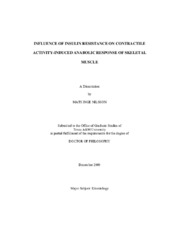| dc.description.abstract | Although the long-term therapeutic benefits of exercise are indisputable, contractile activity may induce divergent adaptations in insulin-resistant vs. insulin-sensitive skeletal muscle. The purpose of this study was to elucidate if the anabolic response following resistance exercise (RE) is altered in myocellular sub-fractions in the face of insulin resistance. Lean (Fa/?) and obese (fa/fa) Zucker rats were assigned to sedentary and RE groups and engaged in either cage rest or four lower-body RE sessions over an 8-d period. Despite obese Zucker rats having significantly smaller hindlimb muscles when compared to age-matched lean rats, basal 24-h fractional synthesis rates (FSR) of mixed protein pools were near normal in distally located muscle groups (gastrocnemius, plantaris, and soleus) and even augmented in those located more proximally (P<0.05; quadriceps). Although 2 x 2 ANOVA indicated a significant main effect of phenotype on mixed FSR in gastrocnemius and soleus (P < 0.05), phenotypic differences were partially accounted for by an exercise effect in the lean phenotype. Interestingly, obese rats exhibited a significant suppression of myofibrillar FSR compared to their lean counterparts (P<0.05; gastrocnemius), while synthesis rates of mitochondrial and cytosolic proteins were normal (gastrocnemius and quadriceps), suggesting a mechanism whereby translation of specific mRNA pools encoding for metabolic enzymes may be favored over other transcripts (e.g., contractile proteins) to cope with nutrient excess in the insulin-resistant state. Immunoblotting of the cytosolic fraction in gastrocnemius muscle indicated an augmented phosporylation of eIF4EBP1 (+ 9%) and p70s6k (+85%) in obese vs. lean rats, but a more potent baseline inhibition of polypeptide-chain elongation as evidenced by an increased phospho/total ratio of eEF2 (+78%) in the obese phenotype. Resistance exercise did not improve synthesis rates of myofibrillar, cytosolic, or mitochondrial proteins to the same extent in obese vs. lean rats, suggesting a desensitization to contractile-induced anabolic stimuli in the insulin-resistant state. We conclude that insulin resistance has diverse effects on protein metabolism, which may vary between muscle groups depending on fiber type distribution, location along the proximodistal body axis, and myocellular sub-fraction, and may blunt the anabolic response to voluntary resistance exercise. | en |


